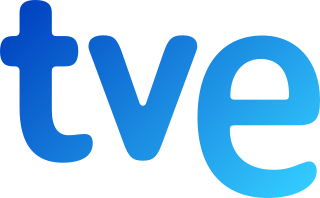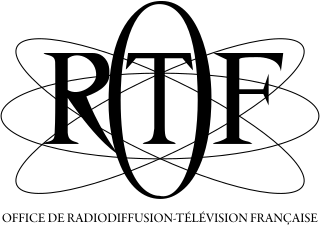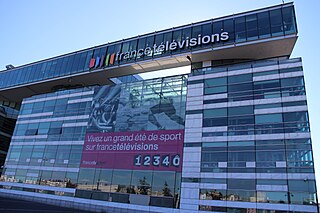Public broadcasting involves radio, television, and other electronic media outlets whose primary mission is public service. Public broadcasters receive funding from diverse sources including license fees, individual contributions, public financing, and commercial financing, and avoid political interference or commercial influence.

Televisión Española is Spain's national state-owned public television broadcaster and the oldest regular television service in the country. It was also the first regular television service in Equatorial Guinea.

The Société de télédiffusion du Québec, branded as Télé-Québec, is a Canadian French-language public educational television network in the province of Quebec. It is a provincial Crown corporation owned by the Government of Quebec. The network's main studios and headquarters are located at the corner of de Lorimier Street and East René Lévesque Boulevard in Montreal.

TV5Monde, formerly known as TV5, is a French public television network, broadcasting several channels of French-language programming. It is an approved participant member of the European Broadcasting Union.

The Office de radiodiffusion-télévision française was the national agency charged, between 1964 and 1975, with providing public radio and television in France. All programming, especially news broadcasts, were under strict control of the national government.
France 3 is a French free-to-air public television channel and part of the France Télévisions group, which also includes France 2, France 4, France 5 and France Info.
Arte is a European public service channel dedicated to culture. It is made up of three separate companies: the Strasbourg-based European Economic Interest Grouping (EEIG) ARTE, plus two member companies acting as editorial and programme production centres, ARTE France in Paris and ARTE Deutschland in Baden-Baden.

France Télévisions is the French national public television broadcaster. It is a state-owned company formed from the integration of the public television channels France 2 and France 3, later joined by the legally independent channels France 4, France 5 and France Info.

The Swiss Broadcasting Corporation is the Swiss public broadcasting association, founded in 1931, the holding company of 24 radio and television channels. Headquartered in Bern, the Swiss Broadcasting Corporation is a non-profit organisation, funded mainly through radio and television licence fees (79%) and making the remaining income from advertising and sponsorship.
Sky Television plc was a public limited company which operated a nine-channel satellite television service, launched by Rupert Murdoch's News International on 5 February 1989. Sky Television and its rival British Satellite Broadcasting suffered large financial losses, and merged on 2 November 1990 to form British Sky Broadcasting. A programming merger took effect on 1 December 1990.

Ici ARTV is a Canadian French language specialty channel owned by the Canadian Broadcasting Corporation. The channel broadcasts the arts and culture including music, dance, theatre, visual arts, films and scripted television series.

Globecast is a service company for the radio, television and media industry, providing solutions for media and content management, aggregation, formatting, processing, transmission and distribution. These contents are feeding various television and radio platforms: direct-broadcast satellite (DBS), digital terrestrial television (DTT), cable TV, IPTV, TV for internet connected screens, digital signage networks, cinema theaters. Globecast is a key player in this industry, serving the needs for top 100 television broadcasters in the world.

D2-MAC is a satellite television transmission standard, a member of Multiplexed Analogue Components family. It was created to solve D-MAC's bandwidth usage by further reducing it, allowing usage of the system on cable and satellite broadcast. It could carry four high quality sound channels or eight lower quality audio channels. It was adopted by Scandinavian, German and French satellite broadcasts. The system was used until July 2006 in Scandinavia and until the mid-1990s for German and French sound channels.

La Une is a Belgian national television channel, owned and operated by the French-language public-service broadcasting organization RTBF. La Une is the equivalent of Flemish station VRT 1, of the Flemish broadcaster VRT.

Tipik is a Belgian national television channel, owned and operated by the French-language public-service broadcasting organization RTBF.

Canal J is a French subscription television channel dedicated to children's programming. It is aimed at children aged 7 to 12.
Television in France was introduced in 1931, when the first experimental broadcasts began. Colour television was introduced in October 1967 on La Deuxième Chaîne.
La Cinq was a French free-to-air television channel. Created by politician Jérôme Seydoux and Italian media mogul Silvio Berlusconi, it existed from 1986 to 1992.

Eutelsat 5 West A, formerly Atlantic Bird 3 was a communications satellite belonging to the operator Eutelsat. Situated at 5° West, it broadcast satellite television, radio and other digital data. Developed for France Telecom it was transferred soon after its launch to the operator Eutelsat. It entered operational service in early September 2002. Its anticipated working life was 15 years. It was decommissioned in January 2023.

TV6 was a French private and free national television channel dedicated to music and youth, created on 1 March 1986. Following the 1986 French legislative election, the new opposition government reallocated its slot to M6, leading to its shutdown exactly a year later on 28 February 1987, becoming the first French national television channel to permanently cease broadcasting. M6 took over its frequencies on the following morning of 1 March 1987.














